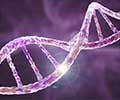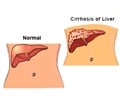Single alteration in the epidermal growth factor gene increases, significantly, the risk that individuals with cirrhosis of the liver will develop hepatocellular carcinoma, a liver tumor.
Researchers from Massachusetts General Hospital Cancer Center and colleagues in France have discovered that a single alteration in the epidermal growth factor gene increases, significantly, the risk that individuals with cirrhosis of the liver will develop hepatocellular carcinoma, a liver tumor. Incidentally hepatocellular carcinoma is the third leading cause of cancer deaths.
“If these results are confirmed, this EGF variation could be used to determine which cirrhotic patients should be screened more intensively for tumor development,” says Kenneth Tanabe, MD, chief of Surgical Oncology at the MGH Cancer Center, the study’s lead author. “In addition, the molecular pathway controlled by EGF and its receptor EGFR – which is known to be important in several types of cancer – appears to be an excellent target for chemoprevention studies. This is a deadly cancer and so progress in prevention and early detection is critically important.”HCC is the sixth most common solid tumor worldwide and most commonly develops in individuals with cirrhosis, which may be caused by infection with the hepatitis B or C viruses. There are currently no effective treatments for most HCC patients, so there is considerable interest in strategies that may prevent development of the tumor.
EGF’s normal function is to stimulate tissue growth. Animal studies have shown that elevated levels of this protein in the liver lead to tumor development and that blocking the protein’s receptor can prevent development of liver cancer. The current study was designed to determine whether cirrhotic patients with higher EGF levels are at greater risk for liver cancer and to determine the influence of a particular inherited gene on EGF levels in cirrhotic patients.
The researchers focused on a known variation in the EGF gene – the presence of the nucleotide guanine (G) instead of the more common adenine (A) in a particular location – which has been shown to increase EGF secretion in blood cells and raise the risk for malignant melanoma. Individuals inherit one copy of the gene from each parent and therefore have this gene with either two copies of A (A/A), two copies of G (G/G), or one copy of each (A/G). Genetic analysis of liver tumor cell lines showed that messenger RNA transcribed from DNA strands with the G allele was more stable that that transcribed from the A version, which could explain why cells with two G copies tend to secrete higher levels of EGF.
The researchers then studied tissue samples from all patients in the MGH Cancer Center Tumor Bank who had cirrhosis. Among the 207 patients with cirrhosis, most of whom were infected with the hepatitis C virus, 59 also had HCC. Patients with at least one copy of the G nucleotide had a significantly higher risk of developing HCC than did A/A patients – ranging from a more than twofold increase for those with one G to an over fourfold increase for those with two G alleles. In all three genotypes, tissue analysis showed that EGF levels were highest in the G/G patients, as was activation of the EGFR receptor. In addition, blood levels of EGF were highest in those with two copies of the G allele.
To confirm these finding in a different patient population, the MGH team worked with colleagues from the Paul Brousse Hospital in Paris. Samples from this group, all of whom had alcoholic cirrhosis, also showed that patients with the G/G version of the EGF gene had a significantly greater risk of developing the liver tumor than did the A/A patients, in this instance an almost threefold risk increase.
Advertisement
“We now need to prospectively study EGF levels in cirrhotic patients, to see if elevated levels will correlate with a greater risk of developing HCC, and look at factors such as diet, drugs or ethnicity that may modulate EGF levels,” Tanabe says. “I think this is a terrific opportunity to see if targeting a specific pathway will prevent HCC in this group of patients, who are at risk for liver cancer because of their cirrhosis.” Tanabe is an associate professor of Surgery at Harvard Medical School.
Advertisement
KAR/M











